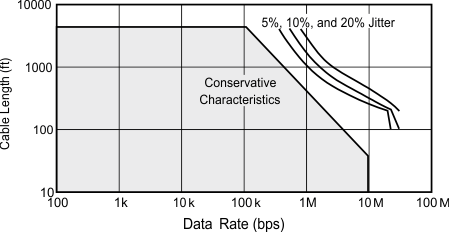ZHCSOI1O august 2009 – july 2023 SN65HVD3082E , SN65HVD3085E , SN65HVD3088E , SN75HVD3082E
PRODUCTION DATA
- 1
- 1 特性
- 2 应用
- 3 说明
- 4 Revision History
- 5 Pin Configuration and Functions
-
6 Specifications
- 6.1 Absolute Maximum Ratings
- 6.2 ESD Ratings
- 6.3 Recommended Operating Conditions
- 6.4 Thermal Information, SN65HVD308xE
- 6.5 Thermal Information, SNx5HVD3082E
- 6.6 Electrical Characteristics: Driver
- 6.7 Electrical Characteristics: Receiver
- 6.8 Electrical Characteristics
- 6.9 Switching Characteristics: Driver
- 6.10 Switching Characteristics
- 6.11 Typical Characteristics
- 7 Parameter Measurement Information
- 8 Detailed Description
- 9 Application and Implementation
- 10Power Supply Recommendations
- 11Layout
- 12Device and Documentation Support
- 13Mechanical, Packaging, and Orderable Information
封装选项
机械数据 (封装 | 引脚)
散热焊盘机械数据 (封装 | 引脚)
订购信息
9.2.1.1 Data Rate and Bus Length
The inverse relationship between the data rate and bus length, means the higher the data rate, the shorter the cable length; and conversely, the lower the data rate, the longer the cable can be without introducing data errors. While most RS-485 systems use data rates between 10 kbps and 100 kbps, some applications require data rates up to 250 kbps at distances of 4,000 feet and longer. The longer distances can be achieved by allowing small signal jitter of up to 5 or 10%.
 Figure 9-3 Cable Length vs Data Rate Characteristic
Figure 9-3 Cable Length vs Data Rate Characteristic